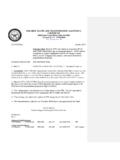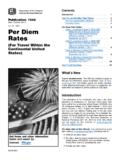Transcription of Part III Administrative, Procedural, and …
1 Part III Administrative, Procedural, and Miscellaneous 26 CFR : Examination of returns and claims for refund, credit, or abatement; determination of correct tax liability. (Also: Part I, 62, 162, 267, 274; , , (a)-1, ) Rev. Proc. 2011-47 SECTION 1. PURPOSE This revenue procedure updates Rev. Proc. 2010-39, 2010-42 459, and provides rules for using a per diem rate to substantiate, under 274(d) of the Internal Revenue Code and ' of the Income Tax Regulations, the amount of ordinary and necessary business expenses paid or incurred while traveling away from home. Taxpayers are not required to use a method described in this revenue procedure. A taxpayer may substantiate actual allowable expenses if the taxpayer maintains adequate records or other sufficient evidence.
2 This revenue procedure provides rules for using a per diem rate to substantiate the amount of an employee s expenses for lodging, meal, and incidental expenses, or for meal and incidental expenses only, that a payor (an employer, its agent, or a third 2 party) reimburses. Employees and self-employed individuals that deduct unreimbursed expenses for travel away from home may use a per diem rate for meals and incidental expenses, or incidental expenses only, under this revenue procedure. This revenue procedure does not provide rules for using a per diem rate to substantiate the amount of lodging expenses only. Announcement 2011-42, 2011-32 138, advised taxpayers that the Internal Revenue Service intends to discontinue the high-low substantiation method. Subsequently a number of taxpayers commented that they use the high-low substantiation method and asked that the Service retain it.
3 Accordingly, this revenue procedure continues to authorize the high-low substantiation method. Beginning with the rates for 2011-2012, the Service will publish an annual notice that provides the special per diem rates for purposes of sections , , and 5 of this revenue procedure and the list of high-cost localities for purposes of section 5 of this revenue procedure and will update this revenue procedure only as necessary. SECTION 2. BACKGROUND AND CHANGES .01 Section 162(a) allows a deduction for ordinary and necessary expenses paid or incurred during the taxable year in carrying on any trade or business, including expenses for travel away from home. However, under ' 262, a taxpayer may not deduct personal travel or living expenses..02 Section 274(n) generally limits the amount allowable as a deduction under ' 162 for any expense for food, beverages, or entertainment to 50 percent of the otherwise allowable amount.
4 For an individual during, or incident to, a period of duty subject to the 3 hours of service limitations of the Department of Transportation, ' 274(n)(3) provides that, for taxable years beginning in 2008 or thereafter, the deductible percentage for these expenses is 80 percent..03 To deduct expenses for travel away from home, a taxpayer must substantiate the expenses under 274(d), which also authorizes the Secretary to prescribe that some or all of the substantiation requirements do not apply to an expense that does not exceed a particular amount..04 Section (g) authorizes the Commissioner to prescribe rules under which reimbursement arrangements or per diem allowances are regarded (1) as equivalent to substantiation, by adequate records or other sufficient evidence, of the amount of travel expenses for purposes of ' (c), and (2) as satisfying the requirements of an adequate accounting to the employer of the amount of travel expenses for purposes of ' (f).
5 05 For purposes of determining adjusted gross income, ' 62(a)(2)(A) allows an employee to deduct business expenses the employee pays or incurs in performing services under a reimbursement or other expense allowance arrangement with a payor..06 Section 62(c) provides that an arrangement is not treated as a reimbursement or other expense allowance arrangement for purposes of ' 62(a)(2)(A) if it (1) does not require the employee to substantiate the expenses covered by the arrangement to the payor, or (2) allows the employee to retain any amount in excess of the substantiated expenses covered under the arrangement. Section 62(c) further provides, however, 4 that substantiation is not required for the expense to the extent provided in regulations under 274(d)..07 Under ' (c), a reimbursement or other expense allowance arrangement satisfies the requirements of ' 62(c) if it meets the requirements of business connection, substantiation, and returning amounts in excess of expenses.
6 In that case, all amounts paid under the arrangement are treated as paid under an accountable plan and are excluded from income and wages. If an arrangement does not meet one or more of these requirements, all amounts paid under the arrangement are treated as paid under a nonaccountable plan and are included in an employee s gross income, must be reported as wages or compensation on the employee s Form W-2, and are subject to the withholding and payment of employment taxes..08 Section (e)(2) provides that the amount of a business expense substantiated under ' (g) is treated as substantiated for purposes of ' .09 Under ' (f)(2), the Commissioner may prescribe rules for treating an arrangement providing per diem allowances as satisfying the requirement of returning amounts in excess of expenses if the arrangement requires the employee to return amounts that relate to unsubstantiated travel days, even though the arrangement does not require the employee to return the portion of the allowance that relates to substantiated travel days but that exceeds the deemed substantiated amount for those days.
7 The allowance must be reasonably calculated not to exceed the amount of the employee's expenses or anticipated expenses and the employee must be required to return within a reasonable period of time any portion of the allowance that relates to 5 unsubstantiated travel days. Under (h)(2)(i)(B), the portion of the allowance that relates to substantiated travel days but exceeds the substantiated amount for those days and that the employee is not required to return is subject to withholding and payment of employment taxes. See '' (a)-3, (e)-1(a)(5), (b)-2, and (a)-4 of the Employment Tax Regulations..10 Under ' (h)(2)(i)(B)(4), the Commissioner may prescribe special rules for the timing of withholding and paying employment taxes on per diem allowances..11 Section (j)(1) authorizes the Commissioner to establish a method allowing a taxpayer to treat a specific amount as paid or incurred for meals while traveling away from home instead of substantiating the actual cost.
8 12 Section (j)(3) authorizes the Commissioner to establish a method allowing a taxpayer to treat a specific amount as paid or incurred for incidental expenses while traveling away from home in lieu of substantiating the actual cost..13 This revenue procedure includes modifications to Rev. Proc. 2010-39 as follows: (1) The special per diem rates are now published in a separate annual notice. The notice provides (1) the special transportation industry meal and incidental expenses rates (M&IE rates ), (2) the rate for the incidental expenses only deduction, and (3) the rates and list of high-cost localities for purposes of the high-low substantiation method. The Service plans to discontinue publishing this revenue procedure annually but will publish modifications as required.
9 This revenue procedure remains in effect until superseded. 6 (2) Section clarifies that partners and volunteers who receive reimbursements from payors may use the methods allowed under this revenue procedure to substantiate their expenses. (3) Under section 5, taxpayers may now use the high-low substantiation method in lieu of the meal and incidental expenses only per diem substantiation method provided in section for travel within the continental United States. (4) Transition rules for the last 3 months of each calendar year are moved from sections (1)(a) and (6) to new section and from section to section SECTION 3. DEFINITIONS .01 Per diem allowance. The term "per diem allowance" means a payment under a reimbursement or other expense allowance arrangement that is -- (1) Paid for ordinary and necessary business expenses incurred, or that the payor reasonably anticipates will be incurred, by an employee for lodging, meal, and incidental expenses, or for meal and incidental expenses, for travel away from home performing services as an employee of the employer, (2) Reasonably calculated not to exceed the amount of the expenses or the anticipated expenses, and (3) Paid at or below the applicable federal per diem rate , a flat rate or stated schedule, or in accordance with any other Service-specified rate or schedule.
10 02 Federal per diem rate and federal M&IE rate. 7 (1) In general. The federal per diem rate is equal to the sum of the applicable federal lodging expense rate and the applicable federal M&IE rate for the day and locality of travel. (a) CONUS rates . The General Services Administration (GSA) publishes the rates for localities in the continental United States (CONUS), as noted in Appendix A to 41 ch. 301. The GSA rates are available on the internet at (b) OCONUS rates . The rates for localities outside the continental United States (OCONUS) are established by the Secretary of Defense ( rates for non-foreign localities, including Alaska, Hawaii, Puerto Rico, the Northern Mariana Islands, and the possessions of the United States) and by the Secretary of State ( rates for foreign localities).












